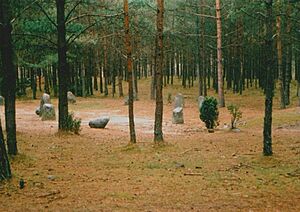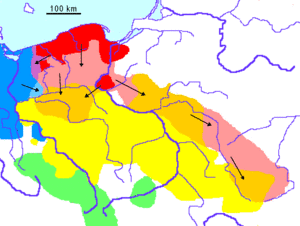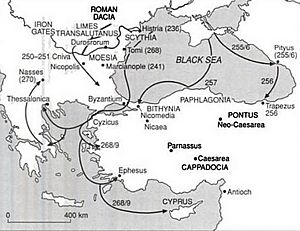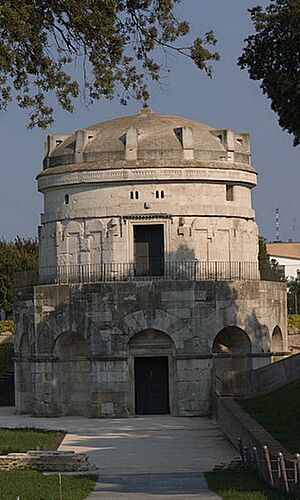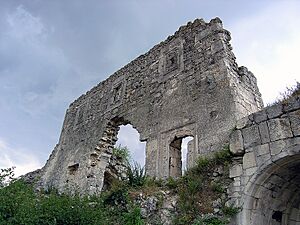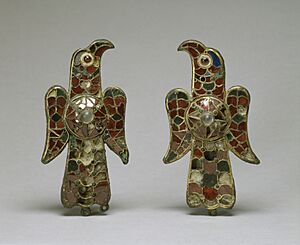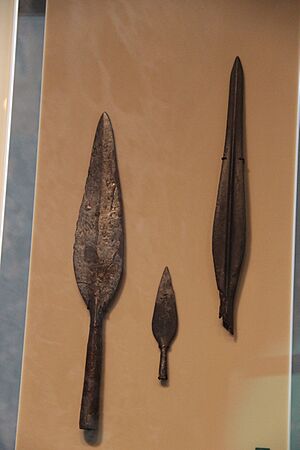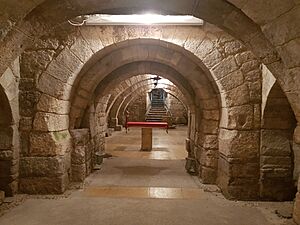Goths facts for kids
The Goths were a Germanic people who played a huge part in the fall of the Western Roman Empire and the start of medieval Europe. They were first mentioned by Greek and Roman writers in the 200s AD. At that time, they lived north of the Danube River in what is now Ukraine, Moldova, and Romania. From there, they often raided Roman lands. Many Goths also joined the Roman army. These early Goths lived in areas where archaeologists find the Chernyakhov culture, which was strong in this region during the 200s and 300s.
In the late 300s, the Goths' lands in Ukraine were taken over by a large movement of Alans and Huns from the east. Many Goths then gathered at the Roman border by the Lower Danube, looking for safety inside the Roman Empire. After they entered the Empire, fighting broke out. Goth-led forces badly defeated the Romans at the Battle of Adrianople in 378. Roman forces got some control back, but many Goths and other eastern peoples quickly settled in and near the empire.
One group, first led by their king Alaric I, became the Visigoths. Their descendants later set up a Visigothic Kingdom in Spain at Toledo. Meanwhile, Goths who were under Hunnic rule became independent in the 400s. The most important of these were the Ostrogoths. Under their king Theodoric the Great, these Goths created an Ostrogothic Kingdom in Italy at Ravenna.
The Ostrogothic Kingdom was destroyed by the Eastern Roman Empire in the 500s. The Visigothic Kingdom was mostly conquered by the Umayyad Caliphate in the early 700s. A small group remained in Asturias and started the Reconquista under Pelagius. Small groups of Goths in Crimea, known as the Crimean Goths, had a culture that lasted for over a thousand years. However, Goths eventually stopped being a separate people.
Gothic architecture, Gothic literature, and the modern-day Goth subculture all get their names from the ancient Goths. But the Goths themselves did not directly create or influence these art forms.
Contents
What's in a Name?
In their own language, Gothic, the Goths called themselves Gut-þiuda ('Gothic people') or Gutans ('Goths'). These names are very similar to those of the Gutes from Gotland, Sweden, and the Geats from mainland Sweden. All these names likely mean the same thing, but their exact meaning is not certain. They are thought to be linked to a very old Germanic word meaning "to pour."
A historian named Jordanes wrote in the 500s that the Goths came from a place called Scandza (Scandinavia) many centuries earlier. They then moved to the Vistula River area. However, experts question how accurate Jordanes' story is for such early times. A people called the Gutones—possibly early Goths—lived near the lower Vistula River in modern Poland in the 1st century. They are linked to the archaeological Wielbark culture.
Who Were the Goths?
Today, experts classify the Goths as a Germanic people. Along with the Burgundians and Vandals, they belong to the East Germanic group. Roman writers from later times did not always call the Goths "Germans." But in modern studies, the Goths are often referred to as Germanic.
The Goths' Story
Where Did They Come From?

A key source for Gothic history is the Getica, written in the 500s by the historian Jordanes. He might have been of Gothic background. Jordanes said he based his book on an older, lost work. Many experts believe Jordanes' story about Gothic origins comes partly from Gothic tribal traditions and has some accurate details. Because of this, Goths are often thought to have come from south-central Sweden.
According to Jordanes, the Goths started on an island called Scandza (Scandinavia). From there, they sailed to an area called Gothiscandza led by their king Berig. Historians disagree on how true this story is. Most scholars agree that Goths moving from Scandinavia is shown in archaeological findings, but the proof is not totally clear. Instead of one big move by an entire people, scholars think it was a slow process of migration over the 1st centuries BC and AD. This was likely after long-term contact and perhaps only involved a few important families from Scandinavia.
Similarities between the name of the Goths, some Swedish place names, and the names of the Gutes and Geats suggest the Goths came from Gotland or Götaland. The Goths, Geats, and Gutes might all have come from an early group of sailors active on both sides of the Baltic Sea.
Experts generally place Gothiscandza in the area of the Wielbark culture. This culture appeared in the lower Vistula River region in the 1st century AD. It replaced the older Oksywie culture. The Wielbark culture is known for burying people instead of burning them, not putting weapons in graves, and having stone circles. This area had strong connections with Scandinavia since the Nordic Bronze Age. Its people during the Wielbark period are usually thought to be Germanic, like the Goths.
Early Adventures
The Goths are generally believed to have been first mentioned by Greek and Roman writers in the 1st century, called Gutones. This link between Gutones and later Goths is debated by some historians.
Around 15 AD, Strabo mentioned the Butones (likely Gutones) as part of a group of peoples under the rule of King Maroboduus. In 77 AD, Pliny the Elder listed the Gutones as one of the peoples of Germania. He said they belonged to the Vandili, one of the five main "German races."
In his book Germania (around 98 AD), Tacitus wrote that the Gotones (or Gothones) and their neighbors were Germanic. They carried round shields and short swords and lived near the ocean. He said they were "ruled by kings, a little more strictly than the other German tribes." Tacitus also wrote that the Gotones helped overthrow King Maroboduus.
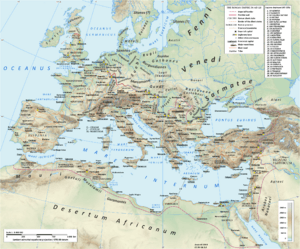
After settling Gothiscandza, Jordanes wrote that the Goths defeated the neighboring Vandals. Experts believe the Gutones became free from Vandal rule in the early 2nd century AD.
In his Geography (around 150 AD), Ptolemy mentioned the Gythones (or Gutones) living east of the Vistula. He also mentioned a people called the Gutae (or Gautae) in southern Scandia, likely the same as the later Gauti.
Moving Towards the Black Sea
Starting in the mid-2nd century, the Wielbark culture moved southeast towards the Black Sea. During this time, the Wielbark culture is thought to have pushed out and partly taken in peoples of the Przeworsk culture. This was part of a larger move south by eastern Germanic tribes, probably because their population grew a lot. This pushed other tribes towards the Roman Empire, helping to start the Marcomannic Wars. By 200 AD, Wielbark Goths were likely being hired into the Roman army.
According to Jordanes, the Goths entered Oium, a part of Scythia, under King Filimer. There, they defeated the Spali. This migration story partly matches what archaeologists have found. The fact that the Goths kept their Gothic language during their move suggests that a fairly large number of people were involved.
By the mid-3rd century AD, the Wielbark culture had helped form the Chernyakhov culture in Scythia. This very similar culture spread from the Danube in the west to the Don in the east. It is believed to have been controlled by the Goths and other Germanic groups. But it also included Iranian, Dacian, Roman, and probably Slavic people.
Raids on the Roman Empire
The first time Goths attacked the Roman Empire was the sacking of Histria in 238. Early mentions of Goths in the 200s called them Scythians, because that area had historically been home to the Scythians. It was in the late 200s that the name Goths was first used. Experts on language have no doubt that the names are connected.
On the Pontic steppe, the Goths quickly learned nomadic customs from the Sarmatians. They became excellent at horsemanship, archery, and falconry. They were also good farmers and sailors. From the 240s, Goths were heavily recruited into the Roman Army to fight in the Roman–Persian Wars.
Meanwhile, Gothic raids on the Roman Empire continued. In 250–51, the Gothic king Cniva captured the city of Philippopolis. He also badly defeated the Romans at the Battle of Abrittus, where the Roman Emperor Decius was killed. This was one of the worst defeats for the Roman army.
The first Gothic raids by sea happened in the 250s. They attacked Asia Minor and later ravaged large areas of Bithynia. By the end of these raids, the Goths controlled Crimea and the Bosporus. This allowed them to carry out many naval activities.
After a 10-year break, the Goths and the Heruli, with 500 ships, attacked Heraclea Pontica, Cyzicus, and Byzantium. They were defeated by the Roman navy but escaped into the Aegean Sea. There, they destroyed islands and sacked cities in southern Greece, including Athens, Corinth, and Sparta. An Athenian army then pushed them north, where the Roman army under Gallienus defeated them.
After Emperor Gallienus was killed in 268, Claudius became emperor. He first dealt with the Alamanni who had invaded Italy. Then he could focus on the invasions in the Balkan provinces.
A second, larger sea invasion had begun. A huge group of Goths (Greuthungi and Thervingi), Gepids, and Peucini, led by the Heruli, gathered at the Dniester River. They failed to storm some towns on the Black Sea coast. Then they attacked Byzantium. Part of their fleet was destroyed. They entered the Aegean Sea and ravaged islands as far as Crete. Their main force was close to taking Thessalonica when they heard the emperor was coming.

Learning Claudius was near, the Goths first tried to invade Italy. They were fought near Naissus by a Roman army led by Claudius. The battle likely happened in 269 and was very tough. Many on both sides died. But at a key moment, the Romans tricked the Goths into a trap by pretending to retreat. About 50,000 Goths were reportedly killed or captured. Their base at Thessalonika was destroyed. Some survivors were settled inside the empire, while others joined the Roman army. This battle helped the Roman Empire survive for another two centuries.
In 270, Goths led by Cannabaudes again invaded the Roman Empire. They were defeated by Aurelian, who then gave up Dacia beyond the Danube. Around 275, the Goths launched a last big attack on Asia Minor. They were defeated in 276 by Emperor Marcus Claudius Tacitus.
By the late 200s, there were at least two groups of Goths, separated by the Dniester River: the Thervingi and the Greuthungi. The Gepids, who lived northwest of the Goths, are also mentioned at this time.
Living Alongside the Romans
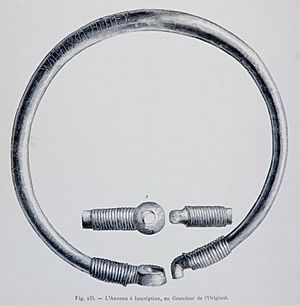
In 332, Constantine helped the Sarmatians settle on the north banks of the Danube to defend against Gothic attacks. About 100,000 Goths were reportedly killed in battle. In 334, Constantine moved about 300,000 Sarmatians from the Danube's north bank after a slave revolt. From 335 to 336, Constantine defeated many Gothic tribes.
Both the Greuthungi and Thervingi became very Romanized during the 300s. This happened through trade with Romans and Goths joining military agreements. Reportedly, 40,000 Goths were brought by Constantine to defend Constantinople. The Palace Guard was mostly Germanic warriors. Goths increasingly became soldiers in Roman armies in the 300s, leading to many Germans in the Roman Army. Without Germanic warriors, the Roman Empire might not have lasted as long. Goths who became important in the Roman military included Gainas and Aspar. Mardonius, a Gothic eunuch, was the childhood teacher and advisor of Emperor Julian.
Gothic fashion, like wearing skins, became popular in Constantinople. A Greek bishop named Synesius compared the Goths to wolves among sheep. He made fun of them for wearing skins and questioned their loyalty to Rome.

In the 300s, Ermanaric, a Greuthungian king, started a big expansion. Jordanes said Ermanaric conquered many tribes. He compared Ermanaric's conquests to those of Alexander the Great. He said Ermanaric "ruled all the nations of Scythia and Germany by his own prowess alone." Some experts think Ermanaric controlled a huge area from the Baltic Sea to the Black Sea.
In the 360s, Athanaric, a Thervingian leader, supported a rebel against the Eastern Roman Emperor Valens. In return, Valens invaded Athanaric's lands and defeated him. But he could not get a final victory. Athanaric and Valens then made a peace treaty on a boat in the Danube River. Athanaric refused to step into the Roman Empire. Soon after, Fritigern, a rival of Athanaric, became Arian Christian and gained Valens' favor. Athanaric then started persecuting Christians in his lands.
The Huns Arrive
Around 375, the Huns took over the Alans, an Iranian people living east of the Goths. Then, with the Alans, they invaded the Goths' territory. The Roman historian Ammianus Marcellinus wrote that Hunnic rule over Gothic kingdoms in Scythia began in the 370s.
After Ermanaric died in 376, the Greuthungi slowly came under Hunnic rule. The Huns attacked the Thervingi, and Athanaric hid in the mountains. Battles between the Goths and Huns are described in an old Icelandic saga called "Hlöðskviða" (The Battle of the Goths and Huns).
Even though the Huns took over many Goths, Fritigern approached the Eastern Roman emperor Valens in 376. He asked to settle his people on the south bank of the Danube. Valens allowed this and even helped the Goths cross the river. The Goths were supposed to give up their weapons, but many kept them. The Moesogoths settled in Thrace and Moesia.
The Great Gothic War (376–382)

Corrupt Roman officials treated the Gothic refugees badly. They soon faced a famine. Some were forced to sell their children for rotten dog meat. Angry at this betrayal, Fritigern started a big rebellion in Thrace. Gothic refugees, slaves, unhappy Roman workers, and Gothic soldiers who had left the Roman army joined him. This conflict, known as the Gothic War, lasted for several years.
Meanwhile, a group of Greuthungi, led by chieftains Alatheus and Saphrax, crossed the Danube without Roman permission. The Gothic War ended with the Battle of Adrianople in 378. The Romans were badly defeated, and Valens was killed.
After the Goths' big victory at Adrianople, a Roman general named Julius ordered a huge killing of Goths in Asia Minor, Syria, and other parts of the Roman East. Fearing rebellion, Julian tricked the Goths into city streets where they could not escape. He killed both soldiers and regular people. As news spread, Goths rioted, and many were killed.
With Theodosius I becoming emperor in 379, the Romans started a new attack to defeat Fritigern. Around the same time, Athanaric came to Constantinople. He had fled his lands because of Fritigern's plots. Theodosius welcomed Athanaric warmly. Athanaric praised the Roman Emperor. After Athanaric died soon after, the emperor gave him a grand funeral. In 382, Theodosius made a peace treaty with the Thervingi. The Thervingi then became allies of the Romans in Thrace and had to provide soldiers for the Roman army.
Goths Divide and Spread
After the Hunnic attack, two main groups of Goths appeared: the Visigoths and Ostrogoths. "Visigoths" means "Goths of the west," and "Ostrogoths" means "Goths of the east." The Visigoths, led by the Balti dynasty, said they came from the Thervingi. They lived as allies inside Roman land. The Ostrogoths, led by the Amali dynasty, said they came from the Greuthungi and were under Hunnic rule. A smaller group, the Crimean Goths, stayed in Crimea and kept their Gothic identity until the 1700s.
Visigoths: Goths of the West
The Visigoths were a new Gothic group formed during the time of their first leader, Alaric I. After many Goths settled in the Balkans in 382, Goths got important jobs in the Roman army. But relations with Roman civilians were sometimes difficult. In 391, Gothic soldiers, with the emperor's approval, killed thousands of Roman spectators in Thessalonica. This was revenge for the killing of a Gothic general.
The Goths suffered many losses fighting for Theodosius in a civil war in 394. In 395, after Theodosius I died, Alaric and his Balkan Goths invaded Greece. They sacked Piraeus (Athens' port) and destroyed Corinth and other cities. Athens itself was saved by paying a large bribe. The Eastern emperor then made Alaric a military leader in 397.
In 401 and 402, Alaric tried twice to invade Italy but was defeated. In 405–406, another Gothic leader, Radagaisus, also tried to invade Italy and was defeated. In 408, the Western Roman emperor ordered the execution of a Roman general and his family. He then encouraged Romans to attack and kill many Gothic families whose men served in the Roman military. After this, about 30,000 Gothic soldiers joined Alaric. Alaric then invaded Italy, trying to make the emperor let his people settle in North Africa. In Italy, Alaric freed tens of thousands of Gothic slaves. In 410, he sacked the city of Rome. The city's treasures were taken, but the people were treated well, and only a few buildings were burned. Alaric died soon after.
Alaric was followed by his brother-in-law Athaulf. Athaulf was married to the emperor's sister, who had been taken during the sack of Rome. Athaulf settled the Visigoths in southern Gaul. After failing to get Roman approval, Athaulf moved into Hispania (Spain) in early 415. He was killed in Barcelona soon after. He was followed by Wallia, who got the Visigoths accepted as allies in southern Gaul, with their capital at Toulouse. Wallia then badly defeated other Germanic tribes in Hispania.
Wallia was followed by Theodoric I, who finished settling the Goths in Aquitaine. They sometimes attacked Arles, a Roman city, but were always pushed back. In 439, the Visigoths signed a peace treaty with the Romans, which they kept.
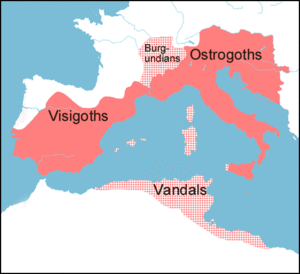
Under Theodoric II, the Visigoths allied with the Romans and fought Attila to a standstill at the Battle of the Catalaunian Fields. Theodoric was killed in this battle. Under Euric, the Visigoths created an independent Visigothic Kingdom. They pushed the Suebi out of most of Spain. Even though they controlled Spain, they were a tiny minority among a much larger Roman-Spanish population.
In 507, the Visigoths were pushed out of most of Gaul by the Frankish king Clovis I at the Battle of Vouillé. They kept some land after Ostrogoth help arrived. This defeat made them move further into Spain and set up a new capital at Toledo.
Under Liuvigild in the late 500s, the Visigoths took over the Suebi and Byzantines, controlling most of the Iberian peninsula. Liuvigild also removed the law that stopped Goths and Roman-Spaniards from marrying. He remained an Arian Christian. When Reccared I converted to Roman Catholicism in the late 500s, Goths started blending with the Roman-Spaniards.
By the end of the 600s, the Visigothic Kingdom had internal problems. Their kingdom fell and was slowly conquered by the Umayyad Caliphate from 711. Some Visigothic nobles found safety in the mountains of Asturias. There, they supported Pelagius's uprising. They joined with local leaders and formed a new noble class. The Christians began to regain control under Pelagius, who founded the Kingdom of Asturias in 718. He defeated the Muslims around 722. This is seen as the start of the Reconquista. Modern Spain and Portugal grew from the Asturian kingdom.
The Visigoths never fully became Roman. Instead, they became "Hispanicized" as they spread over a large area and population. They slowly adopted a new culture, keeping little of their original culture except for military customs, some art, family traditions like heroic songs, and some Germanic names still used today in Spain.
Ostrogoths: Goths of the East
After the Hunnic invasion, many Goths became subjects of the Huns. A part of these Goths, led by the Amali family, became known as the Ostrogoths. Others found safety in the Roman Empire, where many joined the Roman army. In 399, Tribigild, a Gothic leader, rebelled and defeated the first Roman army sent against him. Another Goth, Gainas, tried to use this situation to take power in the Eastern Roman Empire. But a pro-Roman Goth named Fravitta stopped him. After this, thousands of Gothic civilians were killed in Constantinople. As late as the 500s, Goths were settled as allies in parts of Asia Minor. Their descendants, who formed an elite army group, still lived there in the early 700s.
The Ostrogoths fought with the Huns at the Battle of the Catalaunian Plains in 451. After Attila's death and the Huns' defeat in 454, the Ostrogoths broke free from Hunnic rule under their king Valamir. Under his successor, Theodemir, they badly defeated the Huns in 468. Then they defeated a group of Germanic tribes in 469, which gave them power in Pannonia.
Theodemir was followed by his son Theodoric in 471. Theodoric had to compete with another Gothic leader for control. Fearing Theodoric's threat to Constantinople, the Eastern Roman emperor ordered Theodoric to invade Italy in 488. By 493, Theodoric had conquered all of Italy. He then formed the Ostrogothic Kingdom. Theodoric settled his entire people in Italy, estimated at 100,000–200,000, mostly in the north. He ruled the country very well. The Goths were a small minority of the population. Marriage between Goths and Romans was forbidden, and Romans were not allowed to carry weapons. Still, the Roman majority was treated fairly.
The Goths were briefly united under one king in the early 500s under Theodoric. He became ruler of the Visigothic kingdom after a Visigothic king died in 507. Soon after Theodoric's death, the Eastern Roman Empire invaded Italy in the Gothic War. This war badly damaged and emptied the Italian peninsula. The Ostrogoths made a brief comeback under their king Totila, but he was killed in 552. After the last stand of the Ostrogothic king Teia in 553, Ostrogothic resistance ended. The remaining Goths in Italy were absorbed by the Lombards, another Germanic tribe, who invaded Italy in 567.
Crimean Goths
Gothic tribes who stayed in the lands around the Black Sea, especially in Crimea, were called the Crimean Goths. In the late 400s and early 500s, the Crimean Goths had to fight off Huns who were moving back east. In the 400s, Theodoric the Great tried to get Crimean Goths to join his wars in Italy, but few were interested. They became part of the Eastern Orthodox Church and were closely linked with the Byzantine Empire.
During the Middle Ages, the Crimean Goths often fought with the Khazars. In the late 700s, John of Gothia, the bishop of Doros, briefly drove the Khazars out of Crimea. He was later made an Eastern Orthodox saint.
In the 900s, the Crimean Goths' lands were again raided by the Khazars. In response, the Crimean Goths allied with Sviatoslav I of Kiev, who then fought and completely destroyed the Khazar Khaganate. In the late Middle Ages, the Crimean Goths were part of the Principality of Theodoro. This was conquered by the Ottoman Empire in the late 1400s. As late as the 1700s, a small number of people in Crimea might still have spoken Crimean Gothic.
Their Language
The Goths spoke a Germanic language. The Gothic language is the oldest Germanic language we have written records for (from the 300s). It is the only East Germanic language with more than just names or short phrases. This makes it very important for studying how languages are related. Gothic is mostly known from the Codex Argenteus, a book now in Uppsala, Sweden. It contains a partial translation of the Bible by Ulfilas.
The language started to decline by the mid-500s. This was due to the Franks' military victories, the end of the Goths in Italy, and their isolation. In Spain, the language lost its use in church when the Visigoths became Catholic in 589. It survived as a home language in Spain and Portugal until the 700s.
A Frankish writer wrote that Gothic was still spoken in the lower Danube area (now Bulgaria) in the early 800s. A related dialect called Crimean Gothic was spoken in Crimea until the 1500s, according to travelers' writings. Most modern experts believe Crimean Gothic did not come from the same dialect that Ulfilas used for his Bible translation.
Gothic Culture
Art and Craftsmanship
Early Art
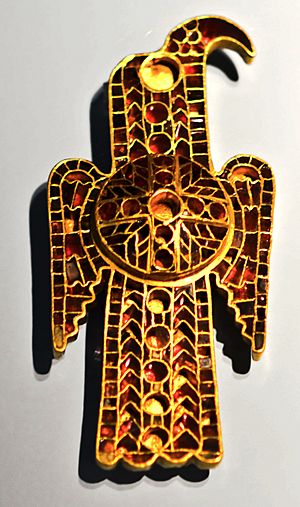
Before the Huns arrived, the Gothic Chernyakhov culture made jewelry, containers, and decorations. Their style was much influenced by Greek and Roman artists. They developed a colorful style of gold work, using cells or settings to put gemstones into their gold objects.
Ostrogothic Art
The eagle-shaped brooch, part of a treasure, was used to fasten clothes around 500 AD. The one in the Germanisches Nationalmuseum in Nuremberg is very famous.
Visigothic Art
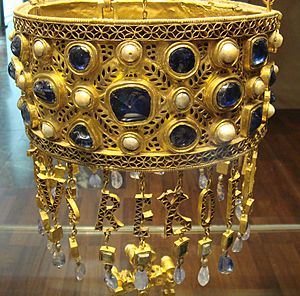
In Spain, an important collection of Visigothic metalwork was found in the treasure of Guarrazar. This archaeological find included twenty-six votive crowns and gold crosses from the royal workshop in Toledo. They showed Byzantine influence. This treasure represents the peak of Visigothic gold work. The two most important crowns are those of Recceswinth and Suintila. Both are made of gold, with sapphires, pearls, and other precious stones.
Eagle-shaped brooches found in burial sites in Spain clearly show the Visigothic presence. These brooches were used alone or in pairs as clasps for clothes. They show the skill of Visigothic goldsmiths.
Visigothic belt buckles are also notable. They were a sign of rank for Visigothic women. Some pieces have beautiful Byzantine-style lapis lazuli inlays.
Daily Life
Archaeological findings in Visigothic cemeteries show that society was divided into groups. Most villagers were common farmers. Poor people were buried with funeral rites, unlike slaves. In a village of 50 to 100 people, there were usually four or five elite couples. In Eastern Europe, houses included sunken-floored homes and surface homes. The largest known settlement is in the Criuleni District. Chernyakhov cemeteries have both cremation and burial graves. Grave goods often include pottery, bone combs, and iron tools, but almost never weapons.
Experts suggest that freemen were the main part of Gothic society. They were below the nobles but above freedmen and slaves. It is thought that about a quarter to a fifth of weapon-carrying Gothic men in the Ostrogothic Kingdom were freemen.
Their Religion
At first, the Goths practiced Gothic paganism. They slowly converted to Arianism during the 300s. In the 300s, the Gothic bishop Ulfilas led missionary work. His grandparents were taken captive in raids in the 250s. Ulfilas created a Gothic alphabet and translated the Gothic Bible.
During the 370s, Goths who became Christian were persecuted by the Thervingian king Athanaric, who was a pagan. The Visigothic Kingdom in Spain converted to Catholicism in the late 500s. The Ostrogoths were closely connected to the Patriarchate of Constantinople from the 400s. They became fully part of the church from the 800s.
How They Fought
Gothic weapons and armor usually included a wooden shield, a spear, and often swords. Regular soldiers did not wear much protection. Warriors of higher social class were better equipped, which was common for most tribes at that time.
Armor was either a chainmail shirt or a lamellar cuirass. Lamellar was popular among horsemen. Shields were round or oval with a central grip. They were decorated with tribe or clan symbols, like animal drawings. Helmets were often of the spangenhelm type, with cheek and neck plates. Spears were used for both thrusting and throwing. Swords were one-handed, double-edged, and straight. Short wooden bows were also used, as well as occasional throwing axes.
Their Economy
Archaeology shows that the Visigoths, unlike the Ostrogoths, were mostly farmers. They grew wheat, barley, rye, and flax. They also raised pigs, chickens, and goats. Horses and donkeys were raised as working animals. Sheep were raised for their wool, which they made into clothing. Archaeology shows they were skilled potters and blacksmiths. When they made peace treaties with the Romans, the Goths demanded free trade. Imports from Rome included wine and cooking oil.
Roman writers noted that the Goths did not collect taxes from their own people or their subjects. A Christian writer from the early 400s compared the Goths' good treatment of the poor to the miserable state of farmers in Roman Gaul. He wrote that Romans living among the Goths wished they would never have to return to Roman rule.
Their Buildings
Ostrogothic Buildings
The Mausoleum of Theodoric is an old monument just outside Ravenna, Italy. Theodoric the Great, an Ostrogoth, built it in 520 AD as his future tomb.
The mausoleum has two ten-sided levels, one above the other. Both are made of stone. Its roof is a single 230-ton stone, 10 meters across. Perhaps as a nod to the Goths' belief they came from Scandinavia, the architect decorated the building with a pattern found in 400s and 500s Scandinavian metal art. A niche leads to a room that was probably a chapel. Stairs lead to the upper floor. In the center of the floor is a round stone grave where Theodoric was buried. His remains were removed during Byzantine rule, when the mausoleum became a Christian chapel.
The Palace of Theodoric, also in Ravenna, has a balanced design with arches and marble columns. The Ostrogoths repaired Roman buildings, and some of these still exist today because of them.
Visigothic Buildings
During their rule in Spain, the Visigoths built several churches that still stand. These include churches with long halls or cross shapes. The Visigothic crypt (underground chapel) in the Palencia Cathedral is a Visigothic chapel from the mid-600s. It was built to hold the remains of a saint.
Reccopolis is an archaeological site near a small village in Spain. It is one of at least four cities founded in Spain by the Visigoths. It is the only city in Western Europe founded between the 400s and 700s. Experts say King Leovigild ordered the city built to honor his son Reccared I. It was meant to be Reccared's seat as co-king.
How They Looked
In old writings, the Goths are always described as tall and athletic. They had light skin, blonde hair, and blue eyes.
What DNA Tells Us
Studies on DNA from Goths of the Wielbark culture show that the culture likely formed from people moving from Southern Scandinavia. Most of the Wielbark culture samples have Scandinavian-like DNA. They also have mostly Scandinavian Y-DNA haplogroups (passed down from father to son). The most common Y-DNA haplogroup among Wielbark people was I1-M253. This is common in the Nordic Bronze Age in Southern Scandinavia.
A 2023 study on the Roman border on the Danube concluded that "Goths were ethnically diverse confederations." Samples from Roman sites from the 200s or later showed a mix of Central/North European and Steppe (from Asia) ancestries. Many of these samples suggest that mixing between these groups happened before they moved into the Roman Empire. This might show how different groups came together under Gothic leadership.
Their Lasting Impact
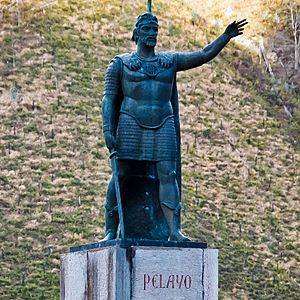
The Goths' connection with Sweden became an important part of Swedish nationalism. Until the 1800s, Swedish scholars thought Swedes were direct descendants of the Goths. Today, scholars call this a cultural movement called Gothicism, which included a love for things from old Norse times.
In medieval and modern Spain, the Visigoths were believed to be the ancestors of the Spanish nobility. By the early 600s, the difference between Visigoths and Roman-Spaniards had almost disappeared. But remembering a Gothic origin, for example on gravestones, still existed among the nobles. The 600s Visigothic nobles saw themselves as having a special Gothic identity and keeping old traditions like Germanic names.
Starting in 1278, when Magnus III of Sweden became king, the title of the king of Sweden included "King of the Swedes, the Goths and the Wends." In 1973, with King Carl XVI Gustaf, the title changed to simply "King of Sweden."
In all history there is nothing more romantically marvellous than the swift rise of this people to the height of greatness, or than the suddenness and the tragic completeness of their ruin.
Spanish and Swedish claims of Gothic origins led to a disagreement at the Council of Basel in 1434. Before discussing religion, they had to decide where to sit. Delegations from important nations argued they should sit closest to the Pope. The Swedish bishop claimed Swedes were descendants of the great Goths. The Spanish delegation replied that only the "lazy" Goths stayed in Sweden, while the "heroic" Goths left, invaded the Roman empire, and settled in Spain.
In Spain, someone acting arrogant might be said to be "haciéndose los godos" ("making himself act like the Goths"). In some South American countries and the Canary Islands, godo was a rude term for European Spaniards. In Colombia, it is still slang for a person with conservative views.
Many books have been written about the Goths. Henry Bradley's The Goths (1888) was the main English book for decades. More recently, Peter Heather has become a leading expert on the Goths in the English-speaking world. In the German-speaking world, Herwig Wolfram is the top expert.
Important Writings About the Goths
In Old Sagas
- Gutasaga
- Hervarar saga ok Heiðreks (The Saga of Hervör and Heidrek)
- Hlöðskviða (The Battle of the Goths and Huns)
In Greek and Roman Books
- Ambrose
- Ammianus Marcellinus
- The anonymous author(s) of the Augustan History
- Aurelius Victor: The Caesars
- Cassiodorus: A lost history of the Goths
- Claudian: Poems
- Epitome de Caesaribus
- Eunapius
- Eutropius: Breviary
- Eusebius
- George Syncellus
- Gregory of Nyssa
- Isidore of Seville in his History of the Kings of the Goths, Vandals, and Suevi
- Jerome: Chronicle
- Jordanes, in his Getica
- Julian the Apostate
- Lactantius: On the death of the Persecutors
- Olympiodorus of Thebes
- Panegyrici latini
- Paulinus the Deacon: Life of bishop Ambrose of Milan
- Paulus Orosius
- Philostorgius: Greek church history
- Pliny the Elder in Natural History
- Procopius
- Ptolemy in Geography
- Sozomen
- Strabo in Geographica
- Synesius: De regno and De providentia.
- Tacitus in Germania and Annals
- Themistius: Speeches
- Theoderet of Cyrrhus
- Theodosian Code
- Zosimus
See Also
 In Spanish: Pueblo godo para niños
In Spanish: Pueblo godo para niños
- Gothic Wars
- Gaut
- Getae
- Gutes
- Geats
- Gothicism
- Gutian people
- Jutes
- Early Germanic culture


